Behaviour: Anting
“Following my series -‘My Odyssey with Blue-winged Pittas’ in 2013 LINK, there had been more developments and opportunities to observe these ground dwellers closer in a different location.
“A mixed secondary forest of mangroves – set along edge of sluggish meandering river, overlooked by a provincial village – with pockets of bamboo groves, bushes and no shortage of damp, ground vegetation were simply ideal habitats for Blue-winged Pittas (Pitta Moluccensis) to thrive and perhaps… to overstay.
“Have their increasing presence edged out the resident Mangrove Pitta (Pitta megarhyncha) in this known location?
“Let’s visit Itam Dalam Forest Reserve Sungai Dua, Peninsular Malaysia – my closest backyard and last remaining decent birding spot for lowland forest birds on mainland Penang State. Aka Province Wellesley, a ‘fossilized’ name I preferred to know instead of montage Seberang Perai.
“A hiatus period of birding activity at the Forest Reserve resulted during the process of reconstruction of a new concrete walkway. Fallen through old, rotten boardwalks eventually were replaced.
“Upon completion last year, this spring saw an increasing number of migratory birds -some newcomers and some lost/forgotten residents being spotted. Perhaps a positive indication habitat recovery is well on the way.
“It was here; no less than two pairs of Blue-winged Pittas allowed my presence to monitor their behaviours up close.
“Whether they had chosen to claim residency status or partial, I hope my follow up visitations and observations do justice to my sightings.
‘A foraging routine of a supposedly male/female caught my attention when observed picking up black ants in an infested car-park area (below left).
“Nibbling at the taste of the insect, the pitta lashed out his/her tongue repulsively like one having chewed on fiery ‘chilli paddy’ or Birdseye chilli (above right, extract from video).
“The bird proceeded to crank his/her neck like a bittern to express repulsion of its corrosive taste and perhaps to even hacked up a saliva mix (below left).
“Similar to feather maintenance, the ground dweller systematically proceeded to tweeze with its beak into under feathers of its body, picking up ants at regular intervals and off-loading its acid mix to rid of ectoparasites especially feather mites (Analgesidae) and lice (Phthiraptera).
“The following are near consecutive images, dated 22nd May 2014 of the Blue-winged Pitta (Pitta moluccensis) showing its meticulous process of anting in preparation for a vital stage in egg incubation.
“The bird began by attending to its left wing (above right)). Image shows protective nictitating membrane layer over left eye during anting process.
“The shuffling of body feathers followed (below left).
“Attention was paid to right wing where nictitating membrane continued to be activated like shutters (above right).
“The left armpit was also attended. Wide spread wings revealed large, white patches of primary feathers that provided clue to its sex. However, the pair I was observing had its female wearing a soiled fawn belly with similar white primary feathering on P10 like the male. Lighter fawn belly in comparison suggested a likely female bird (below left)..
“Attention shifted to its rump (above right).
“This was followed by a good tweeze on its back (below left).
“Oh… the under belly was also not forgotten (above right).
“Finally, the bird picked up more insects to finish off on its hind rear side (above).
“Do breeding males practice courtship feeding?
“Do join me next to witness another insight in feeding behaviours of breeding Blue-winged Pitta.
Avian Writer Daisy O’Neill
PENANG MALAYSIA
13th July 2014
Copyright article and all copyright images – Courtesy of Daisy O’Neill Bird Conservation Fund



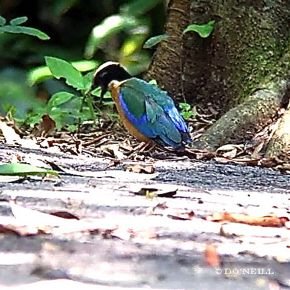

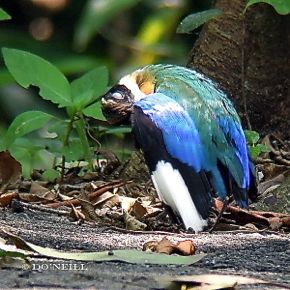
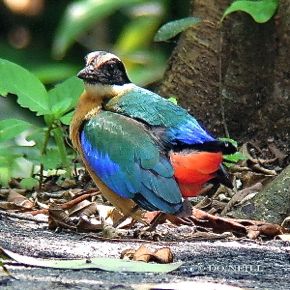

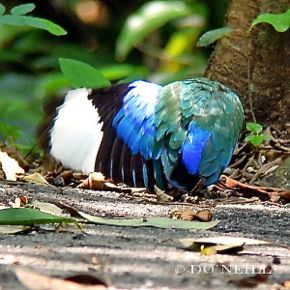
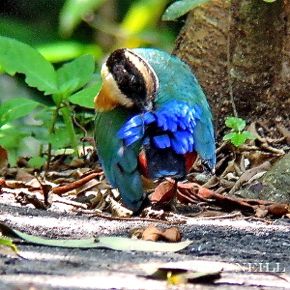

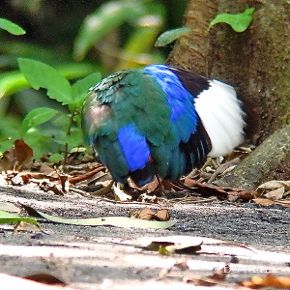
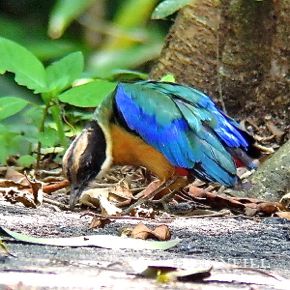
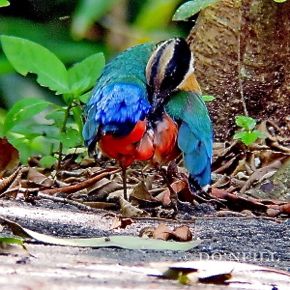







One Response